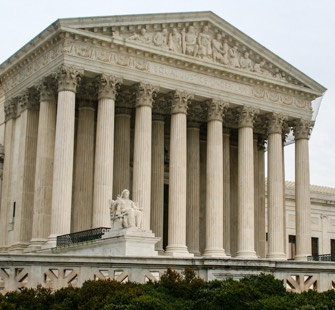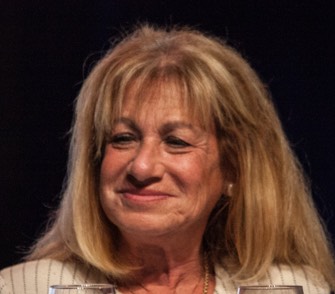Apple v. Samsung remanded back to district court
 Recently, in a non-precedential decision, the United States Court of Appeals for the Federal Circuit remanded Apple, Inc. v. Samsung Electronics Co. back to Judge Lucy Koh (shown left) of the United States Federal District Court for the Northern District of California. In December 2016, the Supreme Court overturned a $400 million damages award for design patent infringement. In its ruling, the Supreme Court explained that damages may be limited to revenues attributable to a component of an article of manufacture and not the entire article itself. See Samsung Electronics Co. v. Apple, Inc.
Recently, in a non-precedential decision, the United States Court of Appeals for the Federal Circuit remanded Apple, Inc. v. Samsung Electronics Co. back to Judge Lucy Koh (shown left) of the United States Federal District Court for the Northern District of California. In December 2016, the Supreme Court overturned a $400 million damages award for design patent infringement. In its ruling, the Supreme Court explained that damages may be limited to revenues attributable to a component of an article of manufacture and not the entire article itself. See Samsung Electronics Co. v. Apple, Inc.
Apple requested that the Federal Circuit keep the case and the panel review the decision in light of the Supreme Court’s ruling, while Samsung requested that the Federal Circuit remand the matter to the district court for a new trial on damages. The Federal Circuit adopted neither suggestion. Instead, the Federal Circuit chose to remand the case for further proceedings, which the panel explained may or may not include a new trial on damages. Judge Koh will decide whether a new trial on damages is necessary.
Supreme Court says district courts have discretion to enhance patent damages
 In a unanimous decision delivered by Chief Justice John Roberts (left) in Halo Electronics, Inc. v. Pulse Electronics, Inc., the United States Supreme Court recently did what much of the patent world expected it would do; they overruled the Federal Circuit’s “unduly rigid” test for the awarding of enhanced damages for willful damages put in place by In re Seagate Technology, LLC, 497 F. 3d 1360, 1371 (2007)(en banc).
In a unanimous decision delivered by Chief Justice John Roberts (left) in Halo Electronics, Inc. v. Pulse Electronics, Inc., the United States Supreme Court recently did what much of the patent world expected it would do; they overruled the Federal Circuit’s “unduly rigid” test for the awarding of enhanced damages for willful damages put in place by In re Seagate Technology, LLC, 497 F. 3d 1360, 1371 (2007)(en banc).
Under Seagate, in order for a patent owner to be entitled to receive enhanced damages of up to triple the original damages award, the patent owner first had to “show by clear and convincing evidence that the infringer acted despite an objectively high likelihood that its actions constituted infringement of a valid patent.” Then, the patentee was required to demonstrate, again by clear and convincing evidence, that the risk of infringement “was either known or so obvious that it should have been known to the accused infringer.” The Supreme Court held that this test was not consistent with the express language of 35 U.S.C. §284.
In the Supreme Court’s recent decisions in Highmark Inc. v. Allcare Health Management Systems, Inc., 134 S. Ct. 1744 (2014) and Octane Fitness, LLC v. ICON Health & Fitness, Inc., 134 S. Ct. 1749 (2014) the Court, interpreting 35 U.S.C. § 285, found that there was no textual support in the statute to impose an onerous, rigid test for the awarding of attorneys’ fees to a prevailing party in a patent infringement lawsuit. Most notably, the Supreme Court explained to the Federal Circuit that they misinterpreted a key ruling of the Supreme Court when they created their test, which would result in attorneys’ fees almost never being awarded.
That same exact misinterpretation was at the heart of Federal Circuit case law relating to an award of enhanced damages to a victorious patent owner, which was why so many believed that the Supreme Court would grant district courts the same discretion with respect to enhanced damages that they were given with respect to attorneys’ fees in 2014 in Highmark and Octane Fitness.
06.27.16 | Patent Damages, Patent Litigation, Supreme Court Cases | Gene Quinn
SCOTUS takes Samsung appeal in Apple design patent infringement case
 On Monday, March 21, 2016, the United States Supreme Court agreed to hear the matter of Samsung Electronics v. Apple, Inc., a dispute between two giant technology companies that at its core relates to how much Samsung owes Apple for infringing certain design patents.
On Monday, March 21, 2016, the United States Supreme Court agreed to hear the matter of Samsung Electronics v. Apple, Inc., a dispute between two giant technology companies that at its core relates to how much Samsung owes Apple for infringing certain design patents.
So far, these two technology giants have shown little interest in playing nice. A jury found that Samsung infringed Apple design patents, Apple utility patents and also diluted Apple’s trade dresses. The infringed design patents are U.S. Design Patent Nos. D618,677 (“D’677 patent”), D593,087 (“D’087 patent”), and D604,305 (“D’305 patent”), which claim certain design elements embodied in Apple’s iPhone. The infringed utility patents are U.S. Patent Nos. 7,469,381 (“’381 patent”), 7,844,915 (“’915 patent”), and 7,864,163 (“’163 patent”), which claim certain features in the iPhone’s user interface. The diluted trade dresses are Trademark Registration No. 3,470,983 (“’983 trade dress”) and an unregistered trade dress defined in terms of certain elements in the configuration of the iPhone.
SCOTUS hears enhanced damages oral arguments February 23, 2016
 On Tuesday, February 23, 2016, the United States Supreme Court will hear oral arguments in Halo Electronics, Inc. v. Pulse Electronics, Inc. (14-1513) and Stryker Corporation v. Zimmer, Inc. (14-1520), which have been consolidated for appeal. These two cases will force the Court to dive into one of the most thorny patent litigation issues – the issue of enhanced damages for willful patent infringement.
On Tuesday, February 23, 2016, the United States Supreme Court will hear oral arguments in Halo Electronics, Inc. v. Pulse Electronics, Inc. (14-1513) and Stryker Corporation v. Zimmer, Inc. (14-1520), which have been consolidated for appeal. These two cases will force the Court to dive into one of the most thorny patent litigation issues – the issue of enhanced damages for willful patent infringement.
The statute in question says very little that is relevant, merely saying that the district court judge “may increase the damages up to three times the amount found or assessed.” 35 U.S.C. § 284. Simple and straightforward enough, but over the years the United States Court of Appeals for the Federal Circuit has issued rulings that make it virtually impossible for a victorious patent owner to ever receive enhanced damages. The rigid structure of the enhanced damages test has effectively removed the permissive and discretionary language of the statute, which just says that the district court judge “may increase the damages.”
In the Supreme Court’s recent decisions in Highmark Inc. v. Allcare Health Management Systems, Inc., 134 S. Ct. 1744 (2014) and Octane Fitness, LLC v. ICON Health & Fitness, Inc., 134 S. Ct. 1749 (2014) the Court, interpreting 35 U.S.C. § 285, found that there was no textual support in the statute to impose an onerous, rigid test for the awarding of attorneys’ fees to a prevailing party in a patent infringement lawsuit. Most notably, the Supreme Court explained to the Federal Circuit that they misinterpreted a key ruling of the Supreme Court when they created the test that would result in attorneys’ fees never being award. That same exact misinterpretation is at the heart of Federal Circuit case law relating to the awarding of enhanced damages to a victorious patent owner.
01.25.16 | Patent Damages, Patent Issues, Patent Litigation, posts, Supreme Court Cases | Gene Quinn
Federal Circuit reverses damages award against Cisco Systems
 On December 28, 2015, the United States Court of Appeals for the Federal Circuit reversed a $63.7 million jury verdict against Cisco Systems. The Court, in an opinion by Chief Judge Prost (pictured), concluded that substantial evidence did not support the jury’s finding that Cisco’s devices, when used, perform the “running” step of the asserted claims.
On December 28, 2015, the United States Court of Appeals for the Federal Circuit reversed a $63.7 million jury verdict against Cisco Systems. The Court, in an opinion by Chief Judge Prost (pictured), concluded that substantial evidence did not support the jury’s finding that Cisco’s devices, when used, perform the “running” step of the asserted claims.
Commil owns U.S. Patent No. 6,430,395, which relates to a method of providing faster and more reliable handoffs of mobile devices from one base station to another as a mobile device moves throughout a network area. In 2007, Commil brought a patent infringement action against Cisco, which makes and sells wireless networking equipment. In a first jury trial, Commil alleged that Cisco directly infringed the ’395 patent by making and using networking equipment, and also that Cisco induced its customers to infringe by selling them the infringing equipment. The jury concluded that Commil’s patent was valid, that Cisco was liable for direct but not induced infringement, and awarded $3.7 million in damages. Commil then filed a motion for a new trial on induced infringement and damages, which the district court granted. The second jury concluded that Cisco was liable for induced infringement and awarded $63.7 million in damages.


No Comments
02.21.17 | District Court Cases, Federal Circuit Cases, Patent Issues | Gene Quinn